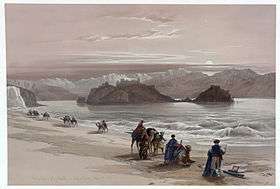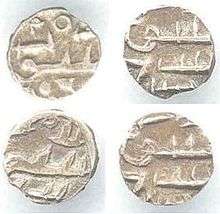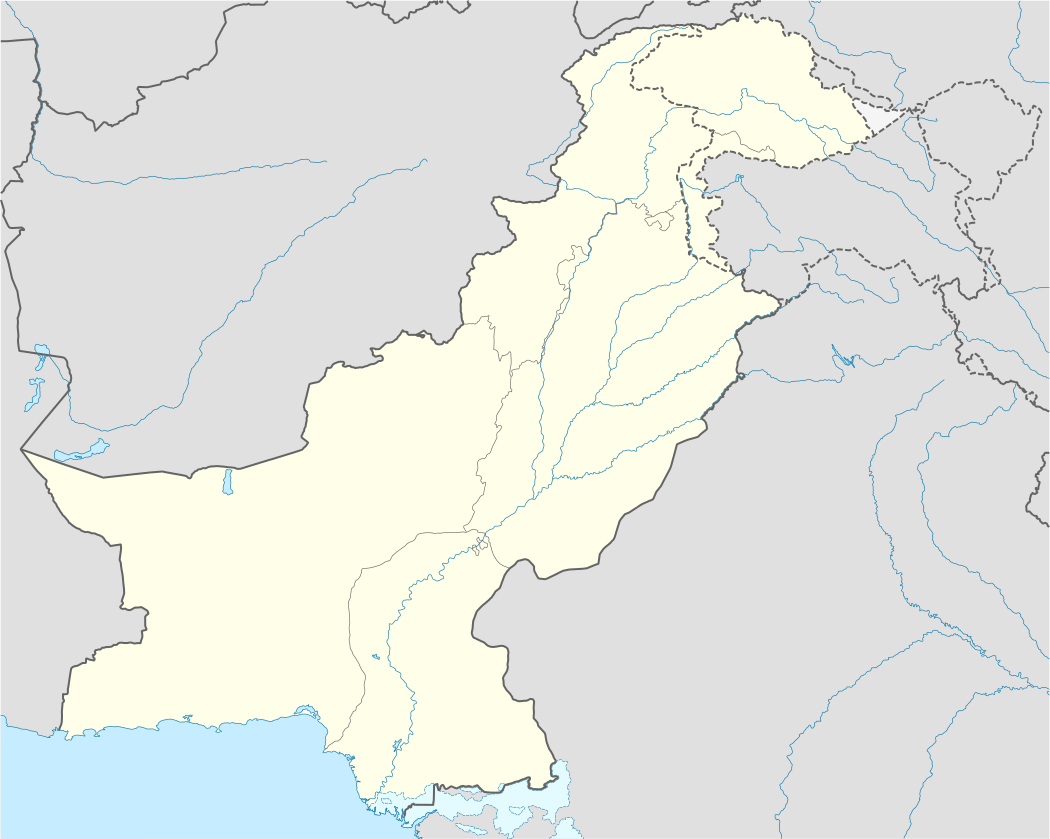Mansura, Sindh
Mansura (Arabic: المنصورة, al-manṣūrah), referred to as "Brahmnabad" in later centuries,[1] was the historic capital of the Muslim Caliphate in Sindh, during the eighth century under the Umayyad Caliphate and then Abbasid Caliphate [2][3] from the year 750 AD to 1006 AD. The city was founded as a central garrison by the Umayyad Forces in Sindh, the city transformed into a very vibrant metropolis during the Abbasid Era surpassing the wealth of Multan in the north and Debal in the south. Mansura was built on the shores of the Indus River, it was surrounded by fertile farmland, Ibn Hauqal mentioned the wealthy local merchants who wore Baghdad Costume and were of Sindhi-Arab origins, houses were made of clay, baked bricks and plaster.

منصورہ (in Urdu) | |
 Coins during the rule of Amirs of Sind, c. 257 -- 421 AH / c. 870 -- 1030 AD | |
 Shown within Sindh  Mansura, Sindh (Pakistan) | |
| Location | Sanghar District, Sindh, Pakistan |
|---|---|
| Coordinates | 25°52′52″N 68°46′37″E |
| Type | Settlement/Capital City |
| Part of | Umayyad Caliphate and Abbasid Caliphate in Sindh |
| History | |
| Periods | Caliphal Period (Umayyad Period) (Abbasid Period) |
| Cultures | Islamic Golden Age Islamic Civilization |
Mansura exported herbs and spices, textiles, ivory, metals and mirrors to Baghdad. There were some renowned educational institutions in the city, Mansura produced the first translation of the Quran in the Sindhi language, it was used widely throughout the Indus region. The city was the hometown of famous historical figures such as Sind ibn Ali he introduced the Arabic numerals and the Zij al-Sindhind; Abu Mashar Sindhi is described by many historians and chroniclers as a pioneer in the compilation of Hadith; Abu Raja Sindhi lived in Baghdad and engaged in scientific and literary pursuits they translated a large number of ancient books of South Asia on mathematics, astronomy, astrology, medicine, literature and ethics into Arabic. According to geologists an earthquake struck both Debal and Mansura in the year 893.AD, the city was later ruled by the Soomro Emirs. Mansura was sacked by the forces of Mahmud of Ghazni because the inhabitants feared his reputation and refused to open the gates. The city never recovered and its Soomro Emirs were deposed.
The city now lies 18 kilometres (11 mi) south-east of Shahdadpur[4] and 75 kilometres (47 mi) north-east of Hyderabad.[1]
History
Erstwhile name of this city was Brahmanabad, which was renamed as Mansura by the Arab invaders.[5] The Umayyad governor of Sind, Al-Hakam, founded a city called al-Mahfuza later called Brahminabad. Historical sources state that he found there were "no places in Sind where Muslims were safe", which indicates there were unrest and rebellions before his arrival.[6] His deputy Al-Thaqafi founded Al-Masura "opposite Al-Mahfuza". Historian Blankship believes that the former was a base for the Yamani troops of the Caliphate and the latter was for the Mudari troops.[6] By the time of Al-Baladhuri, the old Brahamanabad was in ruins, and the new city itself was referred to by the name Brahmanabad.[1]
The city was further developed by Khalid ibn Barmak (705–782), a member of the Persian Barmakids family, during the Abbasid Caliphate. The city holds an important position in Muslim history as the first to be built by Arabs according to the principles of town-planning. Seventeen years later, lessons learned in Mansura were applied in Baghdad where there were once numerous Sindhi inspired buildings and monuments.
Mansura's history began under the Umayyad Caliphs, when Muslim Arabs attempted to conquer the frontier kingdoms of India, Kabul, Zabul, and Sindh. In the early 8th Century, with the Kingdom of Sindh convulsed by internal strife, the Arabs seized their chance and renewed their attacks. Thereafter it was captured by Muhammad ibn Qasim, nephew of al-Hajjaj ibn Yusuf, the governor of Iraq and Khurasan with the Arab Muslim army now known as Arain .Qasim's successors attempted to expand from Sindh into the Punjab and other regions. Al-Masudi ascribed the foundation of the city to Governor Mansur ibn Jamhur, the last Umayyad governor of Sindh. Umar ibn Abd al-Aziz, who belonged to the Banu Habar tribe, the clan of Banu Asad, was the first governor of al-Mansura. Under the Caliphate of al-Mansur, Khalid was appointed governor of Fars and, after helping obtain Prince Isa ibn Musa's renunciation of his succession to the caliphate in 765, became governor of Tabaristan. Around the same time, his son Yahya ibn Khalid, was appointed governor of Adharbayjan.
According to historians, Mansura was a beautiful town with vast orchards of mangoes and groves of date palms. Today the ruins of Mansura are spread over an area 4 miles (6.4 km) in circumference near the modern city of Shahdadpur. The most significant ruin found in Mansura is the large courtyard of a Jamia Masjid (mosque), while the remains of temples were re-used to build structures, leaving no remains other than a small temple structure called a deri (or deval).
Modern ruins
The city lies upon the open sandy plain amongst rolling heaps of brick debris, crisscrossed with the depressions of its original streets and surrounded by the ruins of its once massive walls and bastions. Shaped like a boot with the sole facing north-west and the leg stretching south-east, the whole area has a circumference of 5.75 miles (9.25 km). Apart from a considerable area towards the south-east end, the whole space is covered with billowing mounds of brick ruins. Nothing now stands above the surface, except in one place, where an unrecognizable tower-like core of brick masonry remains. There is a total absence of stone masonry of any kind, but lumps of charred wood dotted here and there indicate the former presence of woodwork. The cement used in the brickwork appears to have been mud which forms the greater mass of the present mounds. As per historian Rahimdad Khan Molai Shedai,"Brahmanabad town was located within 4 miles area, where in the temple named Nu Wihar there was an idol of Buddah.In various history books on Sindh said temple was also written as Nu Bahar which is varied form of Nu Wihar. As Byblion temple priests were astrologers or fortune tellers like priests of Brahmanabad were also great astrologers.The staunch Brahaman king like Chach had to kneel before them and constrained to renovate the temple. The number of the priests in the town was around 1000'.[7]
See also
- Khafif
- Debal
- Multan
- Abbasid Era
- Abu Mashar Sindhi
- Sind ibn Ali
- Ibn Hauqal
- Soomro Dynasty
References
- Wink, Al-Hind, Volume 1 1996, p. 185.
- Ruins of Mansura city in Sindh Pakistan, National Geographic, 29 May 2017.
- Hussain, Irshad. (1989). Mansurah - The First Capital of Muslims in Sindh. Journal of the Pakistan Historical Society 37(3): 293-303.
- Blankinship 1994, p. 335.
- "برهمڻ آباد: تاريخ جي آئيني ۾:محبوب علي چنا". Awami Awaz (in Urdu). 2019-10-26. Retrieved 2020-06-15.
- Blankinship 1994, pp. 186–187.
- Rahimdad Khan Molai Shedai; Janat ul Sindh, 3rd edition, 1993, page 63;Sindhi Adbi Board, Jamshoro
Bibliography
- Blankinship, Khalid Yahya (1994). The End of the Jihâd State: The Reign of Hishām ibn ʻAbd al-Malik and the Collapse of the Umayyads. Albany, New York: State University of New York Press. ISBN 978-0-7914-1827-7.
- Wink, André (1996) [first published 1990], Al-Hind: The Making of the Indo-Islamic World, Vol 1: Early Medieval India and the Expansion of Islam (Third ed.), Brill, ISBN 0391041738
Further reading
- Avari, B. (2012). Islamic civilization in South Asia: A history of Muslim power and presence in the Indian subcontinent. London: Routledge.
- Rashid, N. (1998). Al-Mansurah-The Lost City. Journal of the Pakistan Historical Society 46(4).
- Mansura Archaeological Site Photo
- Sindh Archaeology